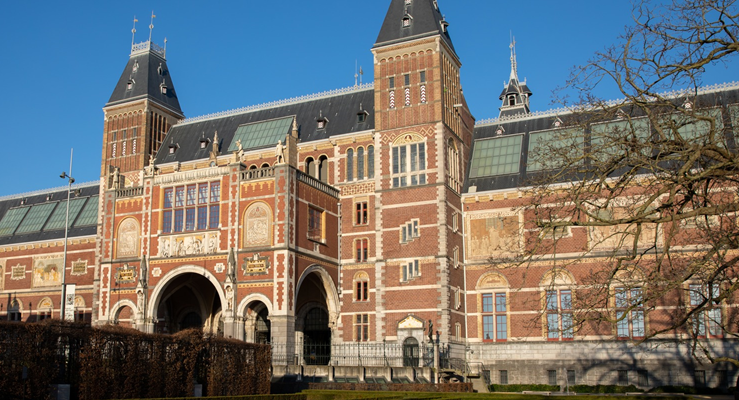The painting ‘Odalisque’ has been in the collection of the Stedelijk Museum, which is owned by the Municipality of Amsterdam, since July 1941.
By Shiryn Ghermezian, The Algemeiner
Amsterdam’s Stedelijk Museum said on Tuesday that it will return a Henri Matisse painting from the 1920s to the heirs of its former Jewish owner, who was forced to sell the artwork in the Netherlands during the Holocaust before being deported to a Nazi camp where he eventually died.
The painting “Odalisque” has been in the collection of the Stedelijk Museum, which is owned by the Municipality of Amsterdam, since July 1941. The painting was sold to the museum by the late Albert Stern, a successful textile manufacturer and art collector in Germany who was born in 1861. He led one of Germany’s leading ladies’ clothing manufacturers that had branches in New York, London, Copenhagen, and Amsterdam. The company’s former headquarters in Berlin is now the building used by the German Federal Ministry of Justice.
Following research into the painting’s provenance, the Dutch Restitutions Committee concluded “that it is sufficiently plausible that the sale of the painting was connected to the measures taken by the occupying forces against Jewish members of the population and arose from a desire for self-preservation,” the Stedelijk Museum said. The committee has advised that the museum return the painting to Stern’s legal successors and the Amsterdam City Council, which owns the painting, will adhere to that advisement.
After Nazi leader Adolf Hitler rose to power in Germany in Jan. 1933, Stern and his family faced persecution for being Jewish and were stripped of their possessions and livelihood. “The Nazis had expropriated [Stern’s] business, its building, the family’s home and its possessions together with most of their assets, and the family had gone into exile, where they continued to be subject to physical threat by the Nazis,” said the Commission for Looted Art in Europe, which represents the Stern heirs.
The Stern family emigrated to the Netherlands in 1937 but, following the Nazi occupation of the Netherlands, they faced additional persecution and made several, unsuccessful attempts to escape. The once wealthy family was forced to sell their remaining possessions to try to survive.
“The family’s circumstances deteriorated to such an extent that it was forced to sell its belongings,” the museum said. “Since the Stern family needed the money to flee, the Restitutions Committee ruled that this was an involuntary loss of possession due to circumstances directly related to the Nazi regime.”
Stern sold the Matisse in one of his last efforts to escape Europe with his family, including his children and grandchildren. However, he was unsuccessful in obtaining visas to other countries, including the United States, Mexico, Haiti, Cuba, Uruguay, Brazil, and the Dominican Republic, according to the Commission for Looted Art in Europe. Stern’s family were all arrested and deported to different Nazi concentration camps, where most of them died except his wife and two of his grandchildren. Stern died in the Laufen internment camp in January 1945.
“The return of the Matisse is a moving and overwhelming moment for us all,” Stern’s heirs said in a statement. “Our grandparents loved art and music and theater, it was the center of their lives. In the few years we had our grandmother after the war, she transmitted that love to us, and it has enriched our lives ever since.”
“The Matisse underwent the same journey from Berlin to Amsterdam as our grandparents. But it stopped there in the Stedelijk, with almost no acknowledgement from whence it came for 80 years,” they added. “The family has carried the scars of its unbearable and tragic history alone. Now finally, thanks to the Dutch Restitutions Committee, this is being acknowledged. The decision has provided symbolic justice to our grandfather.”
Rein Wolfs, director of the Stedelijk Museum, said the museum welcomes the Dutch Restitutions Committee’s conclusion about “Odalisque.”
“It is a step forward that, together with the heirs, represented by the Commission for Looted Art in Europe, we have been able to jointly submit this case to the Dutch Restitutions Committee,” he added. “This artwork represents a very sad history and is connected to the unspeakable suffering inflicted on this family. The ruling of the Restitutions Committee does justice to this history, and we naturally follow their binding advice.”
Touria Meliani, the alderman of culture at the municipality of Amsterdam, called the suffering that Jews experienced during World War II “unprecedented and irreversible.”
“Jewish citizens have had their property, rights, dignity, and in many cases their lives taken away,” Meliani added. “To the extent that anything can be repaired from the great injustice done to them, we as a society have a moral obligation to act accordingly. The return of works of art, such as the ‘Odalisque’ painting, can mean a lot to the victims and is of great importance for the recognition of the injustice done to them. As a city we have a role and responsibility in this.”
